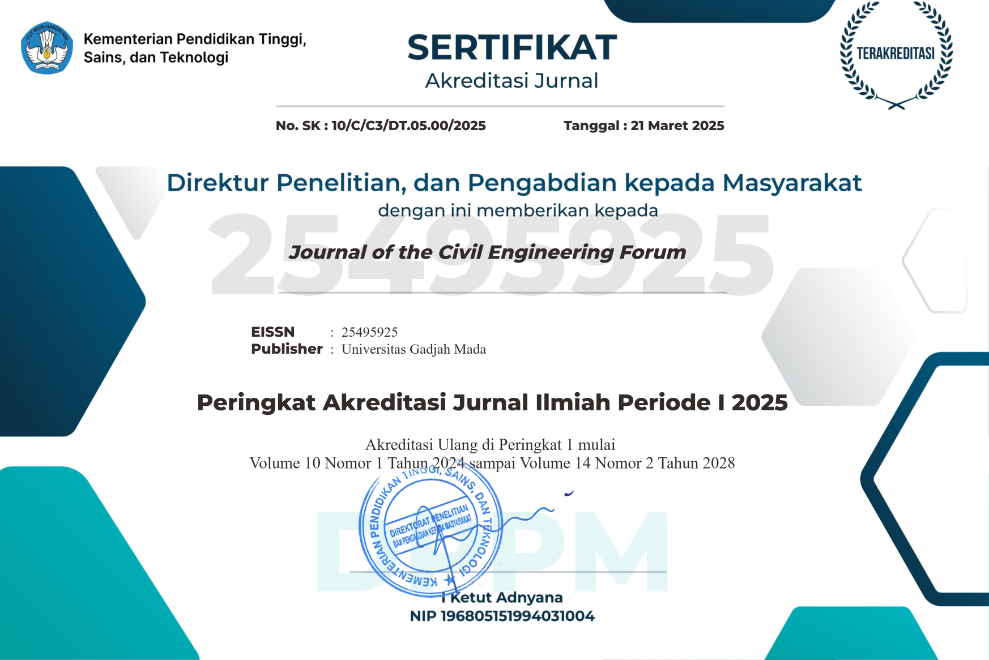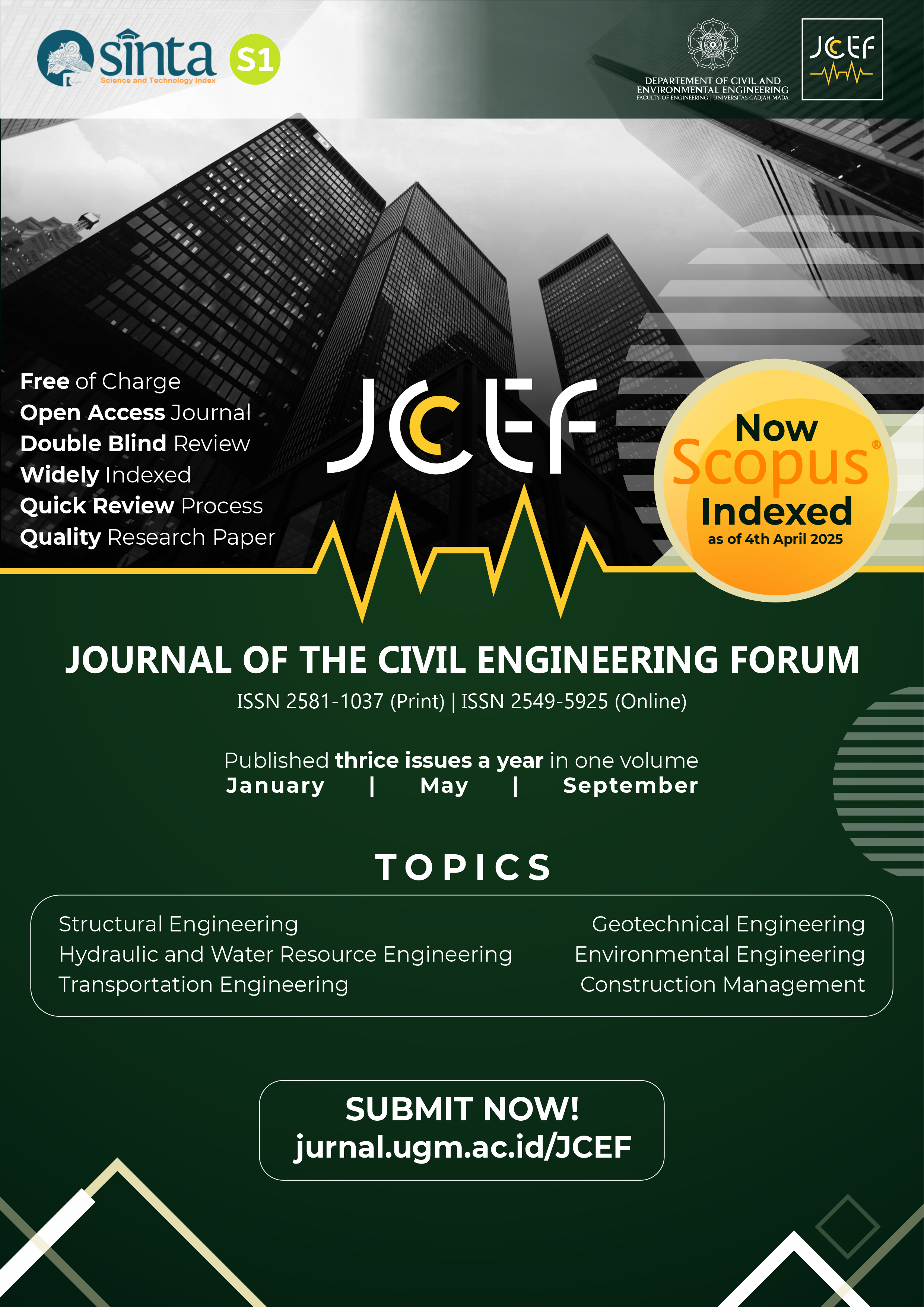A Cyclic Behavior of Multidirectional Box-Shaped Shearing Damper: Experimental Study
Abstract
This paper discusses an experimental study investigating the behavior of the multidirectional box-shaped shearing damper (MBSD) proposed for a bridge structures application. The MBSD consisted of a box-shaped steel plate hot coil (SPHC) material with an effective dimension of 100 x100 mm2 designed to dissipate earthquake excitation energy under combined resultant from longitudinal and transversal directions. The specimens varied with two different web slendernesses, i.e., 58.8 and 27.0. Furthermore, to investigate the different load direction effects, four different loading angles with respect to one of the web planes, i.e., 0°, 15°, 30°, and 45° to be implemented. The specimens were subjected to cyclic loading according to AISC/ANSI 341-22. In the experiment, the shear yield strength, ultimate state behavior, and energy dissipation achievement were evaluated. The result was that MBSD could achieve shear strength and sufficient energy dissipation under different angles of loading direction ranging from yielding to ultimate deformation state. The yielding and ultimate characteristics of MBSD were coincident with the ordinary shear panel damper. A stockier web resulted in a more stable stiffness after the yield point and less buckling of the web but also a slightly earlier strength degradation due to the earlier fracture damage to the welded joint. Finally, the MBSD device had visibility for application on bridge structure as a seismic device by considering appropriate strength and deformation capacity compatibility adjustment with the ultimate displacement limit of 0.11 rad drift angle. In addition, the recommendation for using a better elongation capacity steel material and less welding assembly will improve the behavior and seismic performance of the MBSD.
References
Abebe, D. Y., Kim, J. W., Gwak, G. and Choi, J. H. (2019), ‘Low-cycled hysteresis characteristics of circular hollow steel damper subjected to inelastic behavior’, International Journal of Steel Structures 19(1), 157–167. URL: https://doi.org/10.1007/s13296-018-0097-8
AISC (2020), Specifications for Structural Steel Buildings, American Institute of Steel Construction. URL: https://doi.org/10.1061/taceat.0001170
AISC (2022), Seismic Provisions for Structural Steel Buildings, American Institute of Steel Construction.
Awaludin, A., Setiawan, A. F., Satyarno, I. Shuanglan, W. and Haroki, Y. (2022), ‘Finite element analysis of bidirectional shear panel damper with square hollow section under monotonic loading’, Journal of The Civil Engineering Forum 8(2), 157–168. URL: https://doi.org/10.22146/jcef.3842
Chan, R. W. K., Albermani, F. and Williams, M. S. (2009), ‘Evaluation of yielding shear panel device for passive energy dissipation’, Journal of Constructional Steel Research 65(2), 260–268. URL: https://doi.org/10.1016/j.jcsr.2008.03.017
Chen, Z., Bian, G. and Huang, Y. (2013), ‘Review on web buckling and hysteretic behavior of shear panel dampers’, Advanced Steel Construction 9(3), 205–217. URL: https://doi.org/10.18057/IJASC.2013.9.3.3
Chen, Z. Ge, H. and Usami, T. (2007), ‘Study on seismic performance upgrading for steel bridge structures by introducing energy-dissipation members’, Journal of Structural Engineering 53, 540–549.
Emilidardi, A. M., Awaludin, A., Triwiyono, A., Setiawan, A. F., Satyarno, I. and Santoso, A. K. (2024), ‘Seismic performance enhancement of a pci-girder bridge pier with shear panel damper plus gap: Numerical simulation’, Earthquakes and Structures 27(1), 569–582. URL: https://doi.org/10.12989/eas.2024.27.1.569
Emilidardi, A. M., Setiawan, A. F., Awaludin, A., Satyarno, I. and Sunarso, M. (2022), Numerical model of finned tubular shear panel damper for multi-direction seismic excitation, in ‘S. Belayutham, C.K.I.C. Ibrahim, A. Alisibramulisi, H. Mansor and M. Billah, eds. Proceedings of the 5th International Conference on Sustainable Civil Engineering Structures and Materials’, pp. 751–766. URL: https://doi.org/10.1007/978-981-16-7924-7
Haroki, Y., Awaludin, A., Priyosulistyo, H., Setiawan, A. F. and Satyarno, I. (2023), ‘Seismic performance comparison of simply supported hollow slab on pile group structure with different operational category and shear panel damper application’, Civil Engineering Dimension 25(1), 10–19. URL: https://doi.org/10.9744/ced.25.1.10-19
Jacobsen, L. S. (1930), ‘Steady forced vibrations as influenced by damping’, ASME Transactions 52(1), 169–181.
Kori Effendi, M. and Yulianto, H. (2023), ‘Parametric study of the effect of diameter-to-thickness ratio against bending and shear load on the behavior of round hollow structural section beam’, Journal of the Civil Engineering Forum 10(1), 11–22. URL: https://doi.org/10.22146/jcef.7135
Kurdi, Budiono, B., Moestopo, M., Kusumastuti, D. and Muslih, M. R. (2017), ‘Residual stress effect on link element of eccentrically braced frame’, Journal of Constructional Steel Research 128, 397–404. URL: https://doi.org/10.1016/j.jcsr.2016.09.006
Nakamura, R., Kanaji, H. and Kosaka, T. (2014), Development and design of new steel pipe integrated pier with shear link, in ‘Hanshin Expressway Company Limited. Osaka.’.
Nakashima, M., Iwai, S., Iwata, M., Takeuchi, T., Konomi, S., Akazawa, T. and Saburi, K. (1994), ‘Energy dissipation behaviour of shear panels made of low yield steel’, Earthquake Engineering & Structural Dynamics 23(12), 1299–1313. URL: https://doi.org/10.1002/eqe.4290231203
Santoso, A. K., Awaludin, A., Sulistyo, D., Setiawan, A. F., Sumartono, I. H. and Purnomo, S. (2024), ‘Comparative study of the seismic performance between simply supported psc box girder bridge equipped with shear panel damper (spd ) and lead rubber bearing (lrb )’, International Journal of Technology 15(5), 1–10. URL: https://doi.org/10.14716/ijtech.v15i5.5750
Shirinkam, M. R. and Razzaghi, J. (2020), ‘Experimental and analytical investigation on the behavior of metallic box-shaped dampers (bsd)’, Structures 23, 766–778. URL: https://doi.org/10.1016/j.istruc.2019.12.018
Sun, J., Manzanarez, R. and Nader, M. (2004), ‘Comsuspension cable design of the new san francisco–oakland bay bridge’, Journal of Bridge Engineering 9(1), 101–106. URL: https://doi.org/10.1061/(asce)1084-0702(2004)9:1(101)
Tanaka, K. and Sasaki, Y. (2000), Hysteretic performance of shear panel dampers of ultra low- yieldstrength steel for seismic response control of buildings, in ‘12th WCEE, ed. 12th World Conference on Earthquake Engineering’, pp. 1–8.
Tetsuhiko, A. (2011), ‘Shear-panel type damper, bearing structure of bridge using the same, and the bridge adopting the bearing structure’.
Tetsuhiko, A., Yuuji, F. and Tatsumasa, T. (2010), ‘Shear panel-type damper and bridge’.
Utama, B. N., Satyarno, I., Setiawan, A. F., Awaludin, A. and Aditama, G. M. (2022), Finite element analysis for developing multi-direction crossing web type shear panel damper, in ‘S. Belayutham, C.K.I.C. Ibrahim, A. Alisibramulisi, H. Mansor and M. Billah, eds. Proceedings of the 5th International Conference on Sustainable Civil Engineering Structures and Materials’, pp. 735–749. URL: https://doi.org/10.1007/978-981-16-7924-7
Wang, W., Song, J., Wang, W., Ding, X. and Lu, Z. (2021), ‘Experimental investigation of the seismic behavior of low-yield-point corrugated steel plate dampers’, Journal of Structural Engineering 147(2), 1–14. URL: https://doi.org/10.1061/(ASCE)ST.1943-541X.0002924
Xiang, N., Alam, M. S. and Li, J. (2019), ‘Yielding steel dampers as restraining devices to control seismic sliding of laminated rubber bearings for highway bridges: Analytical and experimental study’, Journal of Bridge Engineering 24(11), 15. URL: https://doi.org/10.1061/(asce)be.1943-5592.0001487
Xiao, L., Li, Y., Hui, C., Zhou, Z. and Deng, F. (2022), ‘Experimental study on mechanical properties of shear square section steel tube dampers’, Metals 12(3), 418. URL: https://doi.org/10.3390/met12030418
Zahrai, S. M. (2015), ‘Cyclic testing of chevron braced steel frames with ipe shear panels’, Steel and Composite Structures 19(5), 1167–1184. URL: https://doi.org/10.12989/scs.2015.19.5.11167
Copyright (c) 2025 The Author(s)

This work is licensed under a Creative Commons Attribution-ShareAlike 4.0 International License.
Copyright is granted to authors for the purpose of providing protection for articles written to describe experiments and their results. JCEF will protect and defend the work and reputation of the author and are also willing to address any allegations of violation, plagiarism, fraud, etc. against articles written and published by JCEF. JCEF is published under the terms of the Creative Commons Attribution-ShareAlike 4.0 International License (CC BY-SA 4.0). The author holds the copyright and assigns the journal rights to the first publication (online and print) of the work simultaneously.







